May 1, 2006
Contacts:
Alan M. MacRobert, Senior Editor
855-638-5388 x151, [email protected]
Marcy L. McCreary, VP Marketing & Business Dev.
855-638-5388 x143, [email protected]
Note to Editors/Producers: This release is accompanied by publication-quality graphics; see details below.
Look southeast after dark this month, and you'll see a bright white "star"
looking right back at you. This is the planet Jupiter, shining so brightly that you can't help but notice it even through city light pollution.
Jupiter blazes so bright mostly because it's a big planet, but also because on May 3rd it is at opposition: positioned opposite the Sun in our sky and at its nearest to Earth for the year. Jupiter will remain nearly as bright for the rest of May and throughout the coming summer, since it doesn't get much farther from us even several months after opposition. It will be the "star" of all the warm-weather nights in 2006.
Telescope users have been following a strange event brewing on Jupiter. Amid the planet's cloud belts, a long-enduring "white oval" unexpectedly turned reddish last February — matching the color of Jupiter's centuries-old Great Red Spot. Both amateur and professional astronomers have been tracking "Red Spot Junior."
Jupiter's spots are enormous cyclonic storms somewhat like hurricanes on Earth. White ones are topped by clouds of ammonia crystals in Jupiter's super-cold upper atmosphere. The reddish tints, planetary astronomers believe, arise from contaminant compounds of sulfur, phosphorus, or hydrocarbons welling up from inside Jupiter's mysterious, gaseous interior.
To see the Great Red Spot and "Red Spot Junior," you'll need a large amateur telescope with high-quality optics. Jupiter rotates once every 9 hours 56 minutes; a list of times when the Great Red Spot crosses Jupiter's centerline, as seen from Earth, appears in the May issue of Sky & Telescope magazine or can be generated online for any date at SkyandTelescope.com/redspot. "Red Spot Junior" follows behind about 1 hour 10 minutes after the Great Red Spot. Examples: on May 3rd, the Great Red Spot is centered at 10:35 p.m. Eastern Daylight Time; on the 12th, at 9:57 p.m. Pacific Daylight Time.
Two Crumbling Comets
Meanwhile, the May night sky offers two different illustrations of how comets in our solar system disintegrate and contribute to the supply of meteors — "shooting stars" — that you occasionally see zipping into Earth's upper atmosphere on a dark night.
1) High in the eastern sky in late evening, amateur astronomers are tracking pieces of Periodic Comet Schwassmann-Wachmann 3 (named for the two German astronomers who discovered it in 1930). It has been crumbling to pieces right before our eyes. The largest two chunks — or rather their gassy, glowing heads and tails — are dimly visible in amateur telescopes if you know exactly where to look. Much better views with the Hubble Space Telescope and the European Southern Observatory's Very Large Telescope in Chile show that several chunks of the disintegrating comet are breaking up even further. More information and sky charts are in the May Sky & Telescope and the May/June issue of Night Sky.
2) The annual Eta Aquarid meteor shower should be at its peak before dawn on May 5th. We see a meteor shower whenever Earth passes through a stream of old comet debris in space. The Eta Aquarid shower is visible mostly from the Southern Hemisphere and the tropics; very few of its meteors are visible from as far north as most of the United States. The Eta Aquarid shower is notable because it consists of debris shed long ago by the famous Halley's Comet, which will next return to our part of space in 2061.
Sky & Telescope is pleased to make the following publication-quality graphics available to our colleagues in the news media. Permission is granted for one-time, nonexclusive use in print and broadcast media, as long as appropriate credit (as noted in the caption) is included. Web publication must include a link to SkyandTelescope.com.
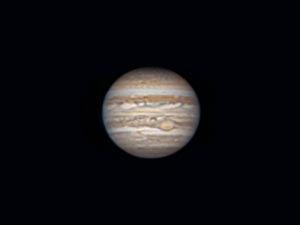
In a large backyard telescope, Jupiter now exhibits two red spots: the Great Red Spot known for centuries, and 'Red Spot Junior,' which developed in early 2006. Florida astronomer Donald Parker captured this view through a 16-inch reflector on April 17th. Click on the image to download a publication-quality version (63K JPEG). A labeled version is also available; see below.
Photo by Donald Parker, courtesy Sky & Telescope.
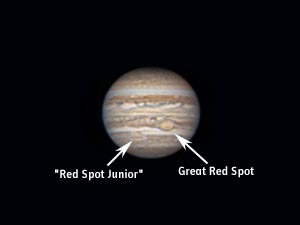
In a large backyard telescope, Jupiter now exhibits two red spots: the Great Red Spot known for centuries, and 'Red Spot Junior,' which developed in early 2006. Florida astronomer Donald Parker captured this view through a 16-inch reflector on April 17th. Click on the image to download a publication-quality version (73K JPEG). An unlabeled version is also available; see above.
Photo by Donald Parker, courtesy Sky & Telescope.
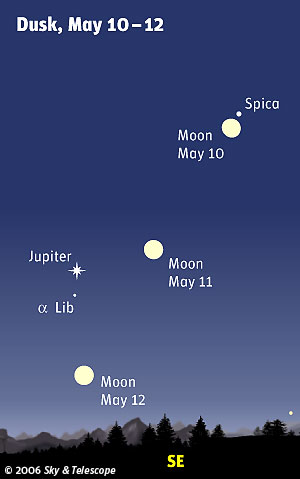
Jupiter is the brightest 'star' in the sky on spring evenings in 2006, hovering low in the southeast. On May 11th the nearly full Moon points the way, with Jupiter to its left. One night later, the full Moon rises almost directly below the brilliant planet. Click on the image to download a publication-quality version (48-kilobyte JPEG).
Sky & Telescope illustration.
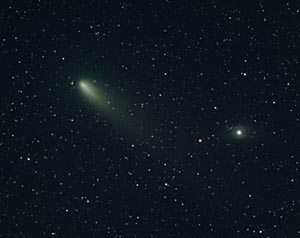
On Friday evening, April 28, 2006, Sky & Telescope assistant editor Sean Walker photographed the main component of Comet Schwassmann-Wachmann 3 as it glided through the constellation Hercules. Click on the image to download a publication-quality version (425-kilobyte JPEG) by anonymous FTP.
Photo by Sean Walker, courtesy Sky & Telescope.
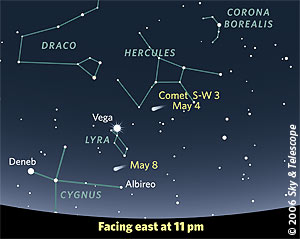
Through early May, Comet Schwassmann-Wachmann 3 can be observed either in the evening or before dawn. Starting May 11th, the comet gets too low to view in the evening, so you'll have to wake up before the Sun to glimpse it. Use binoculars! Click on the image to download a publication-quality version (96-kilobyte JPEG).
Sky & Telescope illustration.
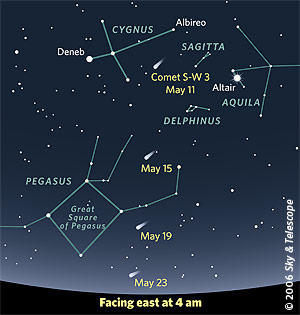
Through early May, Comet Schwassmann-Wachmann 3 can be observed either in the evening or before dawn. Starting May 11th, the comet gets too low to view in the evening, so you'll have to wake up before the Sun to glimpse it. Use binoculars! Click on the image to download a publication-quality version (96-kilobyte JPEG).
Sky & Telescope illustration.
Sky Publishing was founded in 1941 by Charles A. Federer Jr. and Helen Spence Federer, the original editors of Sky & Telescope magazine. The company's headquarters are in Cambridge, Massachusetts, near the Harvard-Smithsonian Center for Astrophysics. In addition to Sky & Telescope and SkyandTelescope.com, the company publishes Night Sky magazine (a bimonthly for beginners with a Web site at NightSkyMag.com), two annuals (Beautiful Universe and SkyWatch), as well as books, star atlases, posters, prints, globes, and other fine astronomy products.
 0
0
Comments
You must be logged in to post a comment.